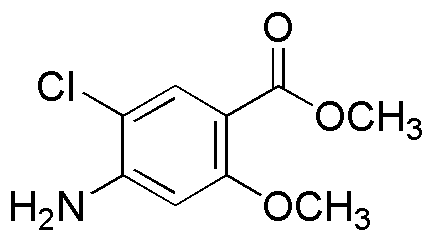4-Amino-5-chloro-o-anisic acid methyl ester is widely utilized in research focused on:
- Pharmaceutical Development: This compound serves as a key intermediate in synthesizing various pharmaceuticals, particularly in the development of anti-inflammatory and analgesic medications.
- Agricultural Chemistry: It is used in the formulation of herbicides and pesticides, helping to enhance crop protection and yield by targeting specific plant growth pathways.
- Biochemical Research: Researchers employ this compound to study enzyme inhibition and receptor interactions, providing insights into metabolic pathways and disease mechanisms.
- Material Science: The compound is explored for its potential in creating novel polymers and materials, which can lead to advancements in coatings and adhesives with improved properties.
- Analytical Chemistry: It is utilized as a standard in chromatographic techniques, aiding in the accurate analysis of complex mixtures in various samples, including environmental and biological matrices.
Informations générales
Propriétés
Sécurité et réglementation
Applications
4-Amino-5-chloro-o-anisic acid methyl ester is widely utilized in research focused on:
- Pharmaceutical Development: This compound serves as a key intermediate in synthesizing various pharmaceuticals, particularly in the development of anti-inflammatory and analgesic medications.
- Agricultural Chemistry: It is used in the formulation of herbicides and pesticides, helping to enhance crop protection and yield by targeting specific plant growth pathways.
- Biochemical Research: Researchers employ this compound to study enzyme inhibition and receptor interactions, providing insights into metabolic pathways and disease mechanisms.
- Material Science: The compound is explored for its potential in creating novel polymers and materials, which can lead to advancements in coatings and adhesives with improved properties.
- Analytical Chemistry: It is utilized as a standard in chromatographic techniques, aiding in the accurate analysis of complex mixtures in various samples, including environmental and biological matrices.
Documents
Fiches de données de sécurité (FDS)
La FDS fournit des informations de sécurité complètes sur la manipulation, le stockage et l’élimination du produit.
Spécifications du produit (PS)
Le PS fournit une description complète des propriétés du produit, notamment sa composition chimique, son état physique, sa pureté et les exigences de stockage. Il détaille également les plages de qualité acceptables et les applications prévues du produit.
Certificats d'analyse (COA)
Recherchez des certificats d'analyse (COA) en saisissant le numéro de lot du produit. Les numéros de lot et de lot se trouvent sur l'étiquette d'un produit, après les mots « Lot » ou « Lot de fabrication ».
Numéro de catalogue
Numéro de lot/série
Certificats d'origine (COO)
Ce certificat d'exploitation confirme le pays dans lequel le produit a été fabriqué, et détaille également les matériaux et composants utilisés et s'il est issu de sources naturelles, synthétiques ou autres sources spécifiques. Ce certificat peut être requis pour les douanes, le commerce et la conformité réglementaire.
Numéro de catalogue
Numéro de lot/série
Fiches de données de sécurité (FDS)
La FDS fournit des informations de sécurité complètes sur la manipulation, le stockage et l’élimination du produit.
DownloadSpécifications du produit (PS)
Le PS fournit une description complète des propriétés du produit, notamment sa composition chimique, son état physique, sa pureté et les exigences de stockage. Il détaille également les plages de qualité acceptables et les applications prévues du produit.
DownloadCertificats d'analyse (COA)
Recherchez des certificats d'analyse (COA) en saisissant le numéro de lot du produit. Les numéros de lot et de lot se trouvent sur l'étiquette d'un produit, après les mots « Lot » ou « Lot de fabrication ».
Numéro de catalogue
Numéro de lot/série
Certificats d'origine (COO)
Ce certificat d'exploitation confirme le pays dans lequel le produit a été fabriqué, et détaille également les matériaux et composants utilisés et s'il est issu de sources naturelles, synthétiques ou autres sources spécifiques. Ce certificat peut être requis pour les douanes, le commerce et la conformité réglementaire.


